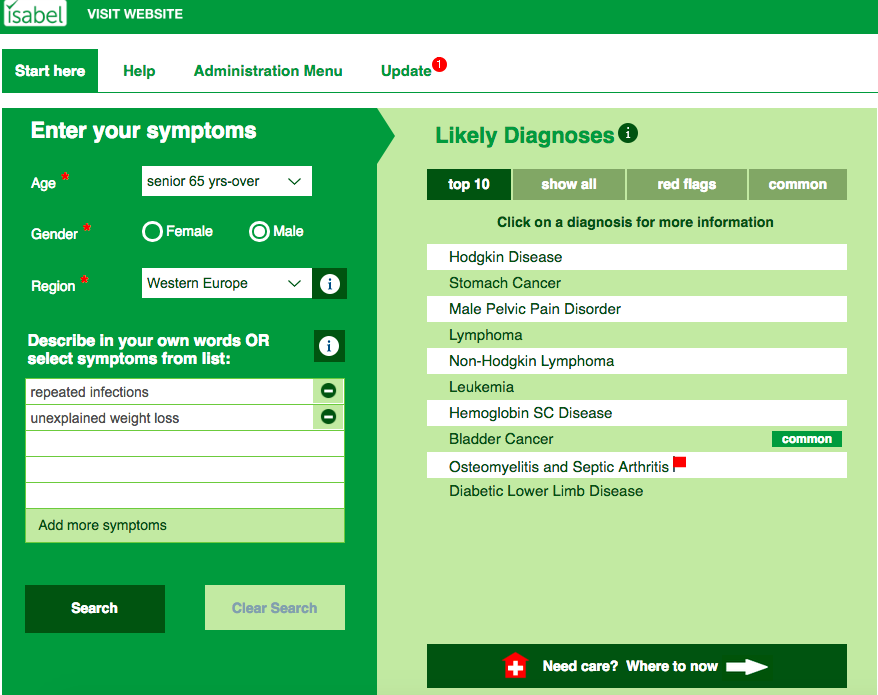- Privacy Policy
- Terms & Conditions
- Contact us
- ©Isabel Healthcare 2025
Could I have blood cancer? Symptoms, Causes and Treatments
 Blood Cancer Awareness Month (BCAM) takes place each September in countries around the world and is dedicated to raising awareness about what blood cancers are, who is affected and calling for improvements in patient care. A recent survey by the NHS in the UK revealed that blood cancers are taking longer to diagnose than most other cancers. Over a third of blood cancer patients visiting their family doctor with symptoms needed to see their doctor at least 3 times before receiving a diagnosis. Phil Reynolds from the UK charity, Bloodwise, explains this is due to a number of factors: “including a lack of awareness of blood cancer symptoms and the ease in which many symptoms can be confused with more common conditions. He continues: “for some types of blood cancer, early diagnosis can have a significant impact on outcome for patients” which is why BCAM is so vitally important to help reduce delayed diagnosis.
Blood Cancer Awareness Month (BCAM) takes place each September in countries around the world and is dedicated to raising awareness about what blood cancers are, who is affected and calling for improvements in patient care. A recent survey by the NHS in the UK revealed that blood cancers are taking longer to diagnose than most other cancers. Over a third of blood cancer patients visiting their family doctor with symptoms needed to see their doctor at least 3 times before receiving a diagnosis. Phil Reynolds from the UK charity, Bloodwise, explains this is due to a number of factors: “including a lack of awareness of blood cancer symptoms and the ease in which many symptoms can be confused with more common conditions. He continues: “for some types of blood cancer, early diagnosis can have a significant impact on outcome for patients” which is why BCAM is so vitally important to help reduce delayed diagnosis.
What is blood cancer?
Blood cancer occurs when your blood cells stop working properly and begin to grow out of control. This can stop your blood doing the jobs it’s normally designed to do, such as fight off infection. In this blog we will be looking at the three main types of blood cancer: leukemia, lymphoma and myeloma; however there are other less common blood conditions which don’t fall into these categories but are nevertheless classified as blood cancer. Within the three groups mentioned above are many different blood cancers, each one affecting a particular type of blood cell, each with its own set of symptoms and outlook. Some blood cancers will be described as ‘acute’ which means they are aggressive and fast-growing while others will be known as ‘chronic’ which are slower to develop and take longer to spread.
The 3 main types of blood cancer
We have previously written an entire blog about hodgkins and non-hodgkins lymphoma and will shortly be writing more detailed blogs about leukaemia and myeloma. In the meantime, below is a brief summary of the key factors of each one:
Leukemia
Leukemia usually starts in the bone marrow leading to an over-production of abnormal white blood cells. White blood cells are an important part of the immune system, so if you notice you’re getting more infections than normal, or they are lasting longer than normal, visit your doctor. The disease also affects the lymph nodes which leads to swollen glands in your neck, armpit or groin. Weakness and tiredness are key symptoms as are nosebleeds, bleeding gums and easy bruising.
Hodgkins and non-hodgkins lymphoma
Lymphoma affects blood cells called lymphocytes, which are part of the body’s immune system found in the lymph system. The key symptom to look out for is swollen glands, particularly in your neck, armpit or groin, but fever, weight loss, night sweats and itching are also linked to the disease.
Myeloma
Myeloma affects the development of plasma cells in your bone marrow. Too many abnormal plasma cells mean there’s not enough room for normal red and white blood cells. The most typical symptom of the disease is severe and long-lasting back pain but myeloma can also affect your muscles, bones and kidneys causing symptoms such as nausea, loss of appetite, itchy skin, breathlessness and bone pain.
What causes blood cancer?
We all have DNA inside each cell in our body, controlling development and behaviour. If the DNA starts to change in the stem cells which make the blood cells in your bone marrow, then your blood cells might start to develop abnormally and therefore become cancerous. The type of blood cancer you have depends on the type of blood cell which has been affected. While we are yet to understand exactly what causes the changes to the DNA, we do know about certain factors which increase your likelihood of developing the condition:
- Age: some blood cancers tend to be more common in older people. For example Myeloma tends to affect older adults whereas Hodgkin Lymphoma is more common in people either between 15-25 or over 50.
- Ethnicity: Many more Myeloma patients come from an Afro-Caribbean background
However, unlike most other cancers, lifestyle choices such as smoking and exercise don’t seem to have a link to these diseases.
Symptoms of blood cancer

As well as the specific symptoms for the different types of cancer explained above, there are some common symptoms for all blood cancers. As mentioned earlier, blood cancers also share symptoms with many other common illnesses which is why it sometimes takes a while for the disease to be correctly diagnosed. While you should not immediately assume you have a blood cancer if you’re suffering from any of the symptoms below, it is still important to discuss all possibilities with your doctor having checked them on the Isabel Symptom Checker. Typical symptoms include:
- Extreme tiredness
- Repeated infections
- Unexplained weight loss
- Easy bruising or bleeding
- Itchy skin
- Lumps or swellings in your neck, head, stomach or groin
- Bone and/or joint pain
Diagnosis and treatment of blood cancer
If blood cancer is suspected most patients will have to endure a number of exploratory blood tests, scans or biopsies before a final diagnosis is reached.
Following this, treatment depends on which cancer you have, whether it’s acute or chronic, as well as your health and circumstances. Some sufferers just have one treatment, others have many different types, depending on what their body can endure. High-intensity treatment options will include chemotherapy, stem cell transplants, immunotherapies, radiotherapy and occasionally surgery. But most of these come with their own side-effects, so some patients opt for low-intensity treatment, namely low-dose chemotherapies, biological therapies and lower dose immunotherapies. Patients suffering from certain types of slow-growing cancers might not even receive immediate treatment, opting instead for the ‘watch and wait’ route where they are monitored closely and will only start treatment as and when they need it.
The treatment options are as wide and varied as the cancers themselves and will be decided by your healthcare team over a period of time once your final diagnosis is ascertained. You can find out more information about the different types of blood cancer, and the treatments available, on the Leukemia Research Foundation website. They are dedicated to conquering all blood cancers, not only leukemia, and there is a lot of information on there to help you.
Subscribe Here!
Recent Posts
Isabel DDx Companion with ChatGPT Integration - to help you diagnose even faster
At Isabel Healthcare, we’ve always been driven by one goal: to make clinical reasoning faster,..Virtual Triage: Do more questions lead to better patient outcomes?
One of the common misconceptions related to virtual triage / symptom checker tools is that the more..List Of Categories
- Differential Diagnosis Decision Support
- Differential diagnosis
- Symptom Checker
- Symptoms
- Medical Error
- Patient Disease Information
- Disease
- Clinical Decision Support
- Diagnostic Decision Support
- Isabel 1 Minute Read
- Diagnosis Error
- Diagnosis Skills Cases
- Healthcare Informatics
- Clinical Reasoning
- Evidence-based Medicine
- Medical Education
- Patient Engagement
- Symptom Triage
- Nurse Practitioner Education
- Nursing Decision Support
- Partnership
- Public Health
- COVID-19
- EHR
- Patient Empowerment
- Patient Safety
- rare disease

Start your FREE Trial today
Try the Isabel Pro DDx generator for 30-days - no payment card details required.



